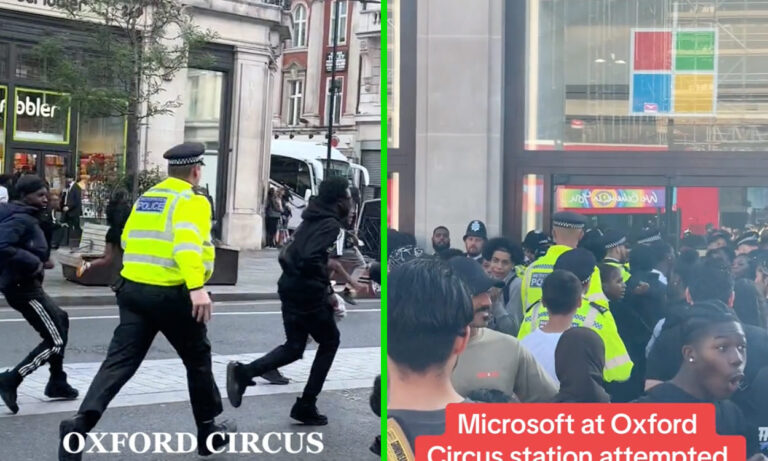Watch these TikToks of Oxford Street being taken over by hundreds of teenagers
London’s bustling Oxford Street descended into chaos on 9 August 2023 as rumours of planned disorder spread like wildfire across TikTok. The incident, which led to the closure of shops and a heavy police presence, saw a total of nine arrests and 34 dispersal orders issued in an attempt to regain control of the situation.
Videos and posts, shared by hundreds of teenagers on the video-sharing platform went viral, urging people to break the law in one of London’s busiest tourist hot spots. The rumours centred around a specific target: JD Sports. As crowds gathered and tensions escalated the chaos spilled into nearby shops, including an optician and pharmacy, who briefly had to close their shutters.
One widely shared post encouraged individuals to don a “dress code” of balaclavas and gloves, and called for a “robbery” of the store, while another post warned: “Don’t come if you can’t run. Don’t bring any weapons.”
@kicking_off Microsoft at Oxford Circus station attempted looting lots of riot Police turned arriving causing the youth to run away #police #999 #london #riotpolice
♬ original sound - Kicking_Off_TV
What initially appeared to be a social media prank, quickly turned into a worrisome reality.
The Metropolitan Police released a statement noting: “We continue to have a highly visible presence in the area of Oxford Street. Anyone coming to the West End with the intention of committing a crime will be dealt with robustly.”
The incident has definitely raised broader questions about the often problematic power of social media.TikTok, a platform known for its viral challenges and trends, inadvertently became a catalyst for these events spiralling out of control, much like the chaos we saw in New York City last week after streamer Kai Cenat accidentally sparked riots while giving away free PS5s.
While social media can be a powerful tool for communication, entertainment, and awareness, incidents like this emphasise the significant risk that social media can pose.
Sadly, as news of the incident spread, so did an unfortunate wave of racist backlash. As users sought to pin the blame and motivation behind the incident on the colour of people’s skin, rather than on far more important factors like financial inequality. Many online platforms are seeing themselves becoming a breeding ground for discriminatory comments especially against the black community. Such responses reveal a darker side of social media, where racism and extremism often embolden people to voice hateful opinions.
It’s important to understand the intricate implications surrounding the recurring phenomena of looting, and riots; It’s a puzzle that often finds its pieces within marginalised minority communities and those residing in economically disadvantaged circumstances. These instances serve as stark illustrations of how our institutionally racist society operates and how these stark inequalities are woven into the fabric of our most marginalised communities.
Take, for instance, the striking contrast between the grandeur of Oxford Street, a shopping paradise hailed as one of Europe’s most luxurious and the adjacent neighbourhoods. A stroll down this bustling avenue places and you’ll witness opulence Yet, surrounding the borough of Westminster where Oxford Street is located, lies a starkly different world—one where economic hardship and underprivileged communities endure.
The common thread that often binds these incidents is rooted in systemic inequities. In areas marked by limited access to quality education, restricted job prospects, and a prevailing sense of societal neglect, the conditions become fertile ground for unrest. These occurrences, far from isolated, mirror deeper societal woes.
Ultimately, the incident raises broader questions about the power of social media to influence real-world actions. It serves as a reminder that the virtual realm’s impact can have profound consequences on the physical world, particularly when combined with underlying societal issues.






